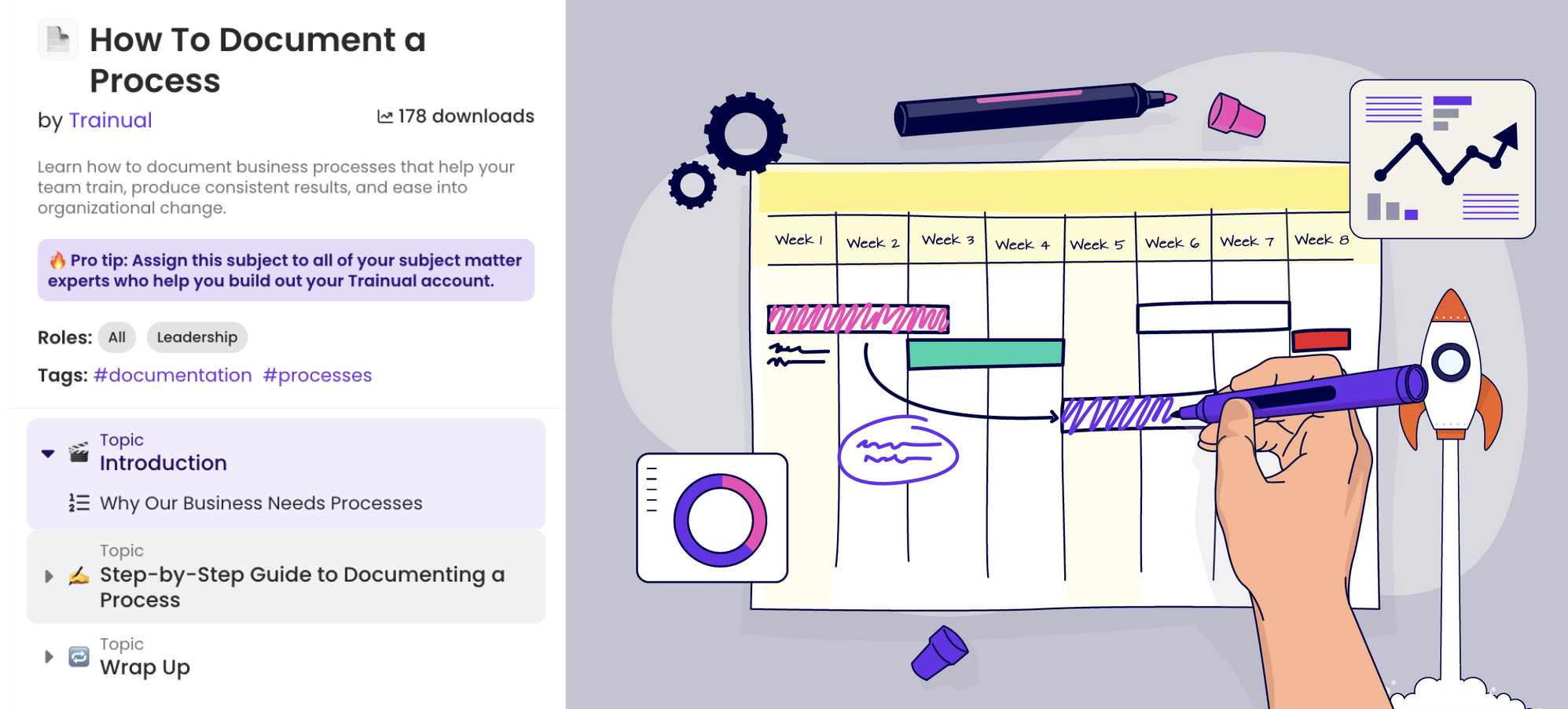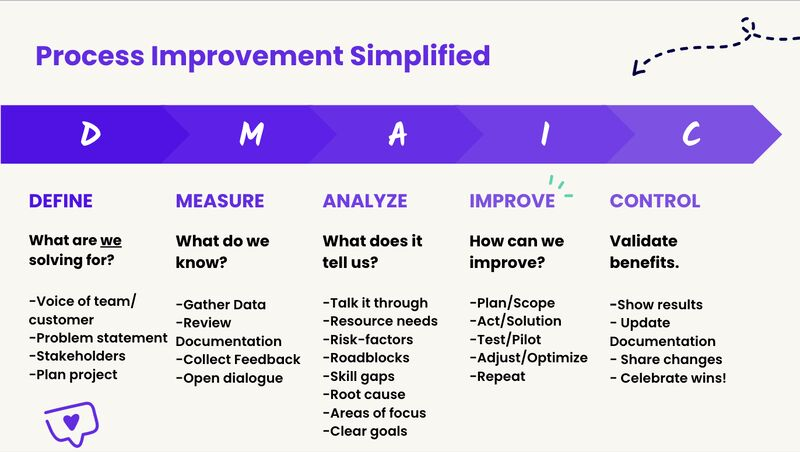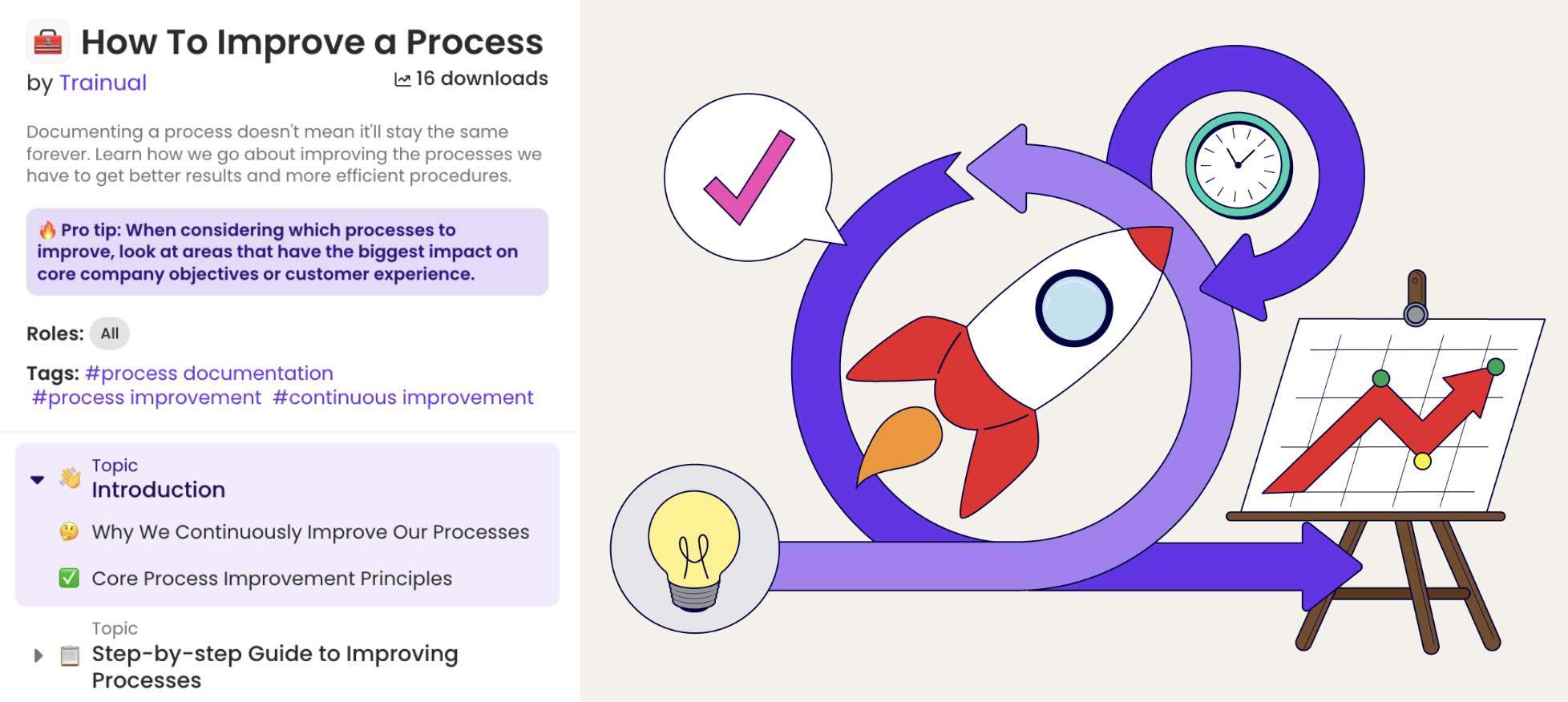
Articles
The Complete Guide to Process Documentation and Process Improvement (with Templates)
March 6, 2024

Starting a business can sometimes feel like stepping into a world of chaos. Every entrepreneur can probably remember when they had a million and one things on their to-do list at any single moment — just to get their business off the ground.
But once the business starts to grow and you add more people to the team, you don’t have to be the one to take care of every single thing. But then, you start to run into a different problem: How can you ensure that the next person who takes over a task can do it as good as you — and make it even better?
You’re not alone — organizations are constantly searching for ways to optimize their operations and increase efficiency. And one powerful resource that can assist businesses in achieving these goals is process documentation.
By capturing, analyzing, and improving their processes, companies can streamline workflows, reduce errors, and ultimately enhance overall performance. With this comprehensive guide, you can learn how to document the processes that run your business — and how to improve them so your business is always developing and pursuing better efficiency and more productivity.
What Is a Business Process?
Before we dive into the intricacies of process documentation, it’s necessary to understand what a business process actually is.
In simple terms, a business process is a repeatable set of activities that are performed in a sequential manner to achieve a specific goal or outcome. Think of any task that you do at your business all the time, like answering customer inquiries or packaging a product for delivery. In normal circumstances, you would follow the same steps and do things the same way to achieve the same results — that’s a business process.
Now, when you’re first starting out, there’s nothing wrong with changing up the way you perform certain tasks. There’s no such thing as progress without experimentation — you have to try different things to see what works best. However, at a certain point, your business needs consistency and assurance that you’ll have the same, good results every time you do something. That’s when business processes become crucial for the efficient functioning of an organization.
They help streamline operations, improve productivity, and enhance overall performance. By clearly defining processes, companies can identify bottlenecks, redundancies, and areas for improvement.
Moreover, business processes can play a key role in compliance and risk management. With business processes, organizations can ensure that they are following industry regulations and best practices. This not only helps mitigate risks but also enhances transparency and accountability.
Understanding the Importance of Process Documentation
Now that we have established what a business process is, let's explore why process documentation is critical for businesses.
At its core, business process documentation involves documenting your activities, along with the associated inputs, outputs, and dependencies. Documentation serves as a roadmap that guides employees through their tasks and ensures consistency and standardization throughout the organization.
Process documentation provides clarity and transparency. By documenting each step and decision within a process, companies can avoid misunderstandings and miscommunications among team members. This fosters collaboration, reduces friction, and increases overall productivity.
Process documentation also facilitates knowledge transfer. If you have to say goodbye to an employee, or someone takes on a new role, having clearly documented processes ensures that the knowledge and expertise associated with those processes will never be lost. This enables smooth transitions and minimizes disruptions in operations.
In addition, process documentation acts as a valuable training tool. New hires can refer to documented processes to quickly familiarize themselves with their responsibilities and expectations. This accelerates their onboarding process and allows them to contribute to the organization more rapidly.
Furthermore, process documentation plays a crucial role in quality management. By documenting processes, organizations can identify inefficiencies, bottlenecks, and areas for improvement. This allows for continuous refinement and optimization of processes, leading to enhanced quality of products or services delivered to customers.
Lastly, process documentation serves as a foundation for compliance and auditing purposes. Having documented processes ensures that organizations can demonstrate adherence to regulations and standards. This is particularly important in industries with strict compliance requirements, such as healthcare, finance, and manufacturing.
In other words, without the actual documentation of your business processes, you don’t have any guarantees that your entire team can perform processes the same way. Sure, you can manually train your employees to perform these tasks, but who has that kind of time, especially if it doesn't sink in initially? And how do you ensure consistent and scalable experiences?
Steps to Creating Effective Process Documentation
Now that we’ve established why process documentation is so important for your business, the question remains: How do you actually document a business process?
The same way you do anything else at your business: with an established step-by-step procedure to help you achieve repeatable results! Creating effective process documentation involves a systematic approach. Here are the key steps to follow:
- Determine a process name and write its description. Easy, right? Just be sure to give your process a name that not only reflects what it’s instructing you to do, but is also easily searchable in your company’s knowledge base (more on this later). Then, give it a description that outlines the process’ purpose and outcome.
- Identify the requirements for a process. This next step can be a little tedious, but necessary. You need to define everything this process needs — from a rough outline of the process steps from start to finish, to the outcome at the end, people involved in the tasks, and any tools necessary for the process’ success.
- Identify an owner for a process. You need someone who’s going to be responsible for this process moving forward. Who can people go to with questions? Who’s going to maintain this process for continued accuracy and eventual improvement? Try to never leave a process unassigned — you need someone now so you can avoid pointing fingers later.
- Write the process. Finally, the main course. Use your rough draft to clearly articulate the process’ purpose, step-by-step instruction, and endpoint (AKA, the expected outcome once the process is complete).
- Use engaging styling and multimedia elements. A block of text isn’t the most exciting thing to read — so you can improve the quality and clarity of your process with supporting videos, graphics, and design elements to make your documentation easier to digest.
- Review a process for accuracy. It’s time to make sure the documented process will actually produce the results it’s supposed to. Ask someone to review your process, so that you can fill in any gaps that emerge during the review.
- Publish and assign a process. Your documented process is ready to share with your team! Assign the process to any role or department who performs it and is required to review it.
And that’s it — you now have a fully documented process!
Hot tip: When documenting each step of the process, consider including real-life examples or case studies to illustrate how the process works in practice. This can help stakeholders relate to the documentation more effectively and understand the implications of each step on the overall outcome. By providing concrete examples, you can enhance the clarity and applicability of the process documentation.
Tools and Templates for Process Documentation
Throughout this entire process, you may have been wondering where you should store your process documentation. Think about it this way: You’re not just documenting processes for the sake of it. You need them to be readily accessible by your team — and formatted in a way that makes it easy for your employees to understand what to do with the process.
That’s why you need an online employee training and knowledge management system that can store your business processes in one easy-to-access platform. The platform should also have a robust search functionality to make it easy for your teams to look up processes to learn and review. If only there were a platform that had all those features for growing business… (*cough* Trainual *cough*).
👉 Want to train your team on the best way to document your business processes moving forward? Implement this “How To Document a Process” template in your employee training so you can ensure consistency and quality across your documented processes.

Why Process Improvement Is as Important as Documentation
By this point, you should be well-aware of why process documentation is crucial for your business. However, your documented process isn’t the finish line — the true power of your business’ efficiency and performance lies in continually analyzing and improving processes based on the documented information.
Whether it’s a result of outside influences or a natural reaction to growth, businesses are constantly changing and making pivots. That means your internal operations are bound to change, and your documented processes can go out of date — and become relatively useless. But that’s where process improvement comes into play.
By embracing a culture of continuous process improvement, you can identify bottlenecks, eliminate redundant steps, and enhance overall efficiency. This iterative approach ensures that processes remain aligned with evolving business needs and industry best practices.
Moreover, process improvement goes beyond just efficiency gains. It can also lead to increased employee satisfaction and engagement. When employees see that their input is valued and that processes are constantly being refined for better outcomes, they are more likely to feel motivated and empowered in their roles. This, in turn, can have a positive impact on overall workplace morale and productivity.
Furthermore, by regularly reviewing and enhancing processes, you can better adapt to changes in the external environment. Whether it's new regulations, technological advancements, or shifts in consumer preferences, a proactive approach to process improvement allows you to stay agile and competitive in a rapidly evolving market landscape.
Analyzing Current Processes for Improvement
Before implementing any changes, it is essential to analyze the current state of your processes. This involves:
- Assessing their effectiveness.
- Identifying areas for improvement.
- Understanding the root causes of any inefficiencies or bottlenecks.
One commonly used technique for process analysis is process mapping. By mapping out the current process flow and analyzing it step by step, you can identify pain points and areas of improvement. Additionally, collecting and analyzing data related to process performance can provide valuable insights into areas for optimization.
Try conducting a SWOT (Strengths, Weaknesses, Opportunities, Threats) analysis to understand the internal and external factors that may impact your current processes. This strategic tool enables you to leverage your strengths, address weaknesses, capitalize on opportunities, and mitigate threats effectively.
Moreover, involving key stakeholders from various departments in the process analysis can offer diverse perspectives and insights. Collaborative brainstorming sessions and feedback mechanisms can help in gaining a comprehensive understanding of the current processes and potential areas for enhancement.
Implementing Changes for Process Improvement
Once you have identified areas for improvement, it's time to implement the necessary changes. This requires careful planning, effective communication, and the involvement of key stakeholders.
Start by creating a cross-functional team to drive the process improvement initiative. This team should have a clear understanding of the current process, its desired outcome, and the necessary steps to bridge the gap between the two. Institute change champions who can help the rest of the team adapt to new changes and implement them efficiently. By involving employees from different departments, you can leverage their diverse perspectives and expertise.
Furthermore, it is essential to establish clear goals and metrics to measure the success of the process improvement efforts. These goals should be specific, measurable, achievable, relevant, and time-bound (SMART). By setting SMART goals, you provide a clear roadmap for the team to follow and ensure that progress can be effectively tracked and evaluated.

Using the DMAIC Methodology
When it comes to actually improving the process, you want to use a structured approach. To keep the project focused on measurable enhancements and implement impactful process changes, consider using the DMAIC methodology:
- Define: Clearly define the process that will be improved and the problems or opportunities to address. This helps you determine the scope of the project and map out the process flow. You also need to define metrics that will gauge improvement.
- Measure: Collect data on the current process and establish baseline metrics. You can quantify defects, cycle times, costs, and other metrics that impact your objectives. Also be sure to assess capabilities and pain points of the current process.
- Analyze: Dig into the root causes of defects, variations, and bottlenecks in the process flow. Once you’ve identified the factors that significantly influence process performance or results, look for ways the process can be simplified or enhanced.
- Improve: Use analysis findings to design an improved process that resolves documented issues. Consider incremental changes as well new ways of working. Be sure to define these implementation steps clearly.
- Control (& Celebrate!): Roll out the new and improved process! Provide training reinforcement to sustain changes, audit process adherence and results, and monitor the new key metrics. You’ll still want to consider further modifications over time to optimize the process.

Another crucial aspect of implementing changes for process improvement is to provide adequate training and resources to employees. Change can be challenging, and your employees may need support to adapt to new processes or technologies.
Measuring the Success of Process Improvement
Measuring the success of process improvement initiatives is crucial to ensure that the desired outcomes are being achieved. Your SMART goals should be the objectives for your process improvement, while key performance indicators (KPIs) can help you track progress and assess the impact of the implemented changes.
Common KPIs for process improvement include metrics such as cycle time, error rates, customer satisfaction, and cost savings. By monitoring these indicators over time, you can evaluate the effectiveness of their improvement efforts and make data-driven decisions for further enhancements.
Tools and Templates for Process Improvement
For all the work that you put into your process improvement, it’s crucial to remember to diligently document the changes that you make. You don’t want your team to continue using the old process when you have a new and improved version ready to produce better results.
That means you need a process documentation tool that not only makes it easy to update your documentation, but also send out notifications when changes have been made. That way, your whole team can stay up to date on your business’ best practices.
👉 Create a streamlined procedure for improving your business processes with this “How To Improve a Process” template. It outlines how to analyze your current processes, implement changes, and monitor results for continuous improvement — that way, your team never has to question how to go about improving your business procedures.

Continuous Monitoring and Updating of Process Documentation
The world of business is a dynamic one. As businesses evolve and new challenges emerge, it becomes crucial to strive for consistency that can continuously deliver results. And if you want your business to perform consistently well, it’s important to implement process documentation and improvement.
By maintaining up-to-date and accurate process documentation, you can ensure ongoing operational efficiency and effectiveness. Your team will not only be more prepared to deliver successful results, but also appreciate the foundation of great training that these documented processes provide.
By following the steps outlined in this guide and leveraging the available tools and templates, you can harness the power of process documentation and process improvement to make your business better every day. With a culture of organization and continuous improvement, you can pave the way for enhanced performance, increased efficiency, and long-term success.
Similar Blog Posts







